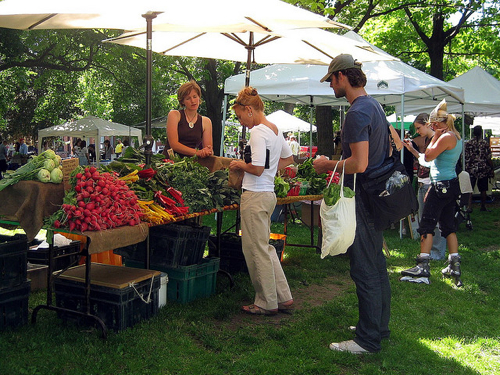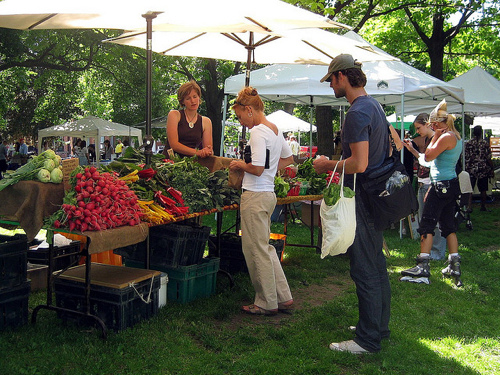 Photo: Matthew BurpeeThe most exciting aspect of the new USDA report on the local food and farm economy [PDF] isn’t the sizable $4.8 billion in annual sales of local food it says occurred in 2008. It’s the fact that, as the AP noted, the local food economy is poised to grow as fast as even the most optimistic estimates. The way things are trending, local food sales in 2011 could pass $7 billion — a number that local food boosters (as well as the USDA itself [PDF]) threw around a few years back. That figure would represent an impressive 15 percent annual increase since 2008, and it’s especially impressive given that we’re still in the teeth of the Great Recession.
Photo: Matthew BurpeeThe most exciting aspect of the new USDA report on the local food and farm economy [PDF] isn’t the sizable $4.8 billion in annual sales of local food it says occurred in 2008. It’s the fact that, as the AP noted, the local food economy is poised to grow as fast as even the most optimistic estimates. The way things are trending, local food sales in 2011 could pass $7 billion — a number that local food boosters (as well as the USDA itself [PDF]) threw around a few years back. That figure would represent an impressive 15 percent annual increase since 2008, and it’s especially impressive given that we’re still in the teeth of the Great Recession.
But that’s not the only interesting tidbit from the report; it also shows that the local food movement has flipped the current agricultural economy on its head. Small farms are king — at least in terms of the number participating — while large farms are minimally involved.
Of course, despite what Big Ag wants you to think, the vast majority of large farms don’t actually grow food. They grow sweeteners, additives, animal feed, fuel, and fiber –or what I like to call Everything But Food. On the other hand, the local food economy is predominantly about selling fruit and vegetables — corn, soy, and cotton growers need not apply.
The USDA also found that the local food economy is concentrated on the West Coast, as well as in the Northeast. Surely population density plays a role, but the study noted that local sales are higher in these two particular areas than in other equally dense regions of the country. The study’s authors speculate that there might be a “neighborhood effect” (though I might call it a “network effect”) of some kind where the presence of a certain critical mass of local farmers makes it more possible for new ones to get into the game.
Farmers with a local market also spend more time farming than their counterparts who don’t sell locally. As the USDA put it, “These measures suggest that the occupational and time commitments to farming are valued more by local food sales farm households than the foregone labor income they could have earned off farm.” And whether those “time commitments to farming” are more valued or simply more necessary when growing food at a smaller scale, it’s still a difference worth noting.
The USDA also analyzed the economic impact of focusing on local sales and found that, though “the same share of farms with and without local food sales earned … profits,” farms that sold locally generally started profiting sooner. For farmers, that’s great news. The report also suggests that local food represents the future of farming in this country. Almost half the farmers selling locally on the West Coast and a third of those doing so in the Northeast are beginners.
This is important given that the average age of farmers nationally is now 57. After all, the older farmers who mostly grow industrial-style commodity (i.e. Everything But Food) agriculture will see their farms fully “chickenized” as they retire and get replaced by massive, corporate-controlled operations.
This good news is offset by the daunting facts just released by the National Young Farmers Coalition. The Coalition found that a menacing three-headed beast of capital, land, and health insurance keeps young farmers from pursuing their dreams. And a recent New York Times article illustrates the challenges and obstacles faced by young farmers, including the fact that only 22 percent of them turn a profit their first year.
Now there’s lots that can be done, from encouraging institutional buying of local food to offering helpful toolkits on rewriting local zoning laws for urban agriculture. But the federal government needs to do its part as well.
That’s where the bill introduced in the House and Senate by Rep. Chellie Pingree (D-Maine) and Sen. Sherrod Brown (D-Ohio) comes into the picture. It’s called the Local Farms, Food, and Jobs Act of 2011 and it would rewrite various aspects of the Farm Bill to support local food sales. It’s full of practical (if not exactly sexy) approaches to improving local food infrastructure, like improving slaughterhouses and institutional sales, but it would also ease access to credit and crop insurance for small and organic farmers. The best part is that, compared to conventional farm subsidies, these kinds of programs are dirt cheap; they cost millions, not billions.
As we’ve discussed, commodity subsidies paid to the largest, richest farmers are already on the chopping block in this round of Farm Bill negotiations (despite the desperate efforts of corporate lobbyists). Can you imagine if even a portion of those funds went to these vital, less expensive efforts?
Of course, our government is of, by, and for the 1 percent right now, so I’d be surprised if changes like these happen right away. But the convergence of this necessary data from the USDA and the policies from forward-thinking legislators might at least create the map needed to rebuild an agriculture system that would grow food (not Everything But), create jobs, and generate income for the middle class. Who can argue with that?




